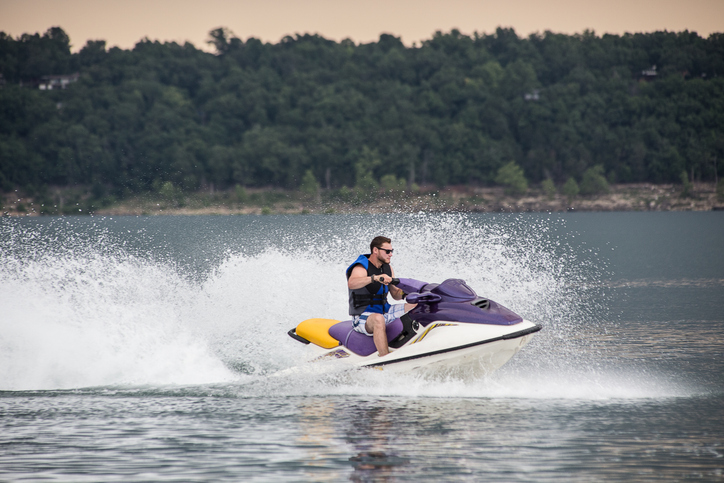How does a jet ski work?
20 August 2025

Understanding how a jet ski works before heading out onto the water is a must for a safe, enjoyable adventure. Whether you’re dreaming of a leisurely ride or hoping to learn a few cool tricks and stunts, a basic understanding of a jet ski engine will help you get the most out of your experience.
In this guide, we discuss what a jet ski is, how its engine works and how fast they go. We’ll cover details on braking and reversing, and provide some top safety tips that all personal watercraft riders should be aware of.
What is a jet ski?
A jet ski, also known as a personal watercraft or PWC, is a small, motorised vehicle that’s ridden on water. It's designed for leisure, and many people enjoy jet skiing for the adrenaline rush it provides.
Jet skis are popular for their high speed, impressive manoeuvrability, and the fact that riding one is loads of fun. They can also be used for wakeboarding or tubing, and others enjoy racing them or performing tricks and stunts.
There are two main types of jet ski: stand-up and sit-down. A stand-up jet ski is perfect if you want to use your personal watercraft for short rides and stunts, whereas sit-down jet skis are best for exploring and going on longer trips. Depending on the sit-down jet ski, you may be able to take up to three passengers with you. Stand-up jet skis are designed for one person.
How do jet ski engines work?
Instead of a traditional external propeller like you’d find on a boat, a jet ski uses an internal jet propulsion system (impeller). This system pulls in water and forces it out through a nozzle at the back, creating thrust that propels the personal watercraft forward.
Speed is controlled by the rider using a throttle and handlebars are used for steering. When the handlebars are turned it moves the nozzle at the back of the jet ski, which forces the craft to turn through the water.
How does a jet ski brake?
Older jet ski models don’t have traditional brakes, and the throttle would need to be released to cut power to the impeller. The jet ski would then be brought to a standstill due to water resistance. Alternatively, if you’re riding an older model you can steer the jet ski side to side or turn quickly to slow the vehicle down, although this requires plenty of skill.
New jet skis have a brake, typically found on the handlebars. Pressing the brake activates a reverse bucket that drops down behind the jet nozzle. This means that instead of shooting water backwards, the jet is redirected forward or downward to create reverse thrust. This thrust slows the jet ski down quickly. Some personal watercrafts have the opportunity for gradual braking so you can slow down gently or come to a fast emergency stop depending on the circumstances.
Can jet skis reverse?
The short answer is yes; jet skis can reverse. However, like with braking, how a personal watercraft reverses depends on the age and model of the vehicle. Older jet skis typically can’t reverse, and going backwards requires using body weight and paddling it manually.
With new jet ski models, the engine keeps pushing water out the back and a reverse bucket lowers over the jet nozzle. This redirects the water forward, causing the jet ski to move backward.
Being able to reverse a jet ski is useful for many reasons, including parking and moving safely away from people, boats, or obstacles. It also provides a stronger sense of control, especially for beginners.
How fast will a jet ski go?
How fast a jet ski goes depends on the model, engine size, and what it’s been designed for. For example, a recreational jet ski can get up to speeds of between 40mph and 55mph, whereas a customised personal watercraft designed for racing could reach speeds of over 80mph.
Like when driving a car, there are speed limits in place for those on the water. These limits are typically put in place by local authorities, so always check the rules for the body of water you’re heading to before you get started.
Who can ride a jet ski?
In the UK, you don’t need to have a licence to ride a jet ski on open water. However, you will need to be aware of and follow the rules set out by harbours and local authorities. Some harbours require a certificate or permit, whereas others may need proof of an RYA (Royal Yachting Association) Personal Watercraft Proficiency Certificate.
The same is similar for age restrictions. While there isn’t a legal age limit for riding a jet ski in the UK, the RYA advises that riders should be at least 12 years old, and all riders aged between 12 and 16 should be under adult supervision. In line with local authority and harbour rules, riders will often need to be 16 or older to use a jet ski.
If you’d like to take passengers on your jet ski, they must be old enough to hold on securely and wear a life jacket. There’s no legal requirement for the age of a jet ski passenger, but it’s recommended that they’re at least five years old or tall enough to sit safely and comfortably on the vehicle. Personal watercrafts often come with recommendations for maximum passengers and minimum ages, so ensure you check these and follow the guidelines.
Personal watercraft safety tips
As with all vehicles, jet skis should be ridden with care and attention to reduce the risk of injury to yourself or others. Personal watercraft safety tips to consider include:
- wear a life jacket, even if you’re a confident swimmer
- follow local laws and speed limits – for example, the speed limit is typically 10mph when riding close to the shore
- avoid crowded or shallow areas for the safety of others
- always keep a safe distance from swimmers and boats
Specialist jet ski insurance through GJW Direct
Now you know how a jet ski works and how to stay safe while riding yours, you may consider specialist jet ski and personal watercraft insurance though GJW Direct to help financially protect you while out on the water.
Get an instant online quote today.
Please note the information provided on this page should not be taken as advice and has been written as a matter of opinion. For more on insurance cover and policy wording, see our homepage.
Got a question? Call our UK call centre 0151 473 8000
©Copyright Ripe Thinking Limited 2026. GJWDirect® is a registered trademark and a trading name of Ripe Insurance Services Limited which is Authorised and Regulated by the Financial Conduct Authority No.313411.
Registered office: One Stockport Exchange, Railway Road, Stockport, United Kingdom, SK1 3SW. Registered in England No. 04507332.
